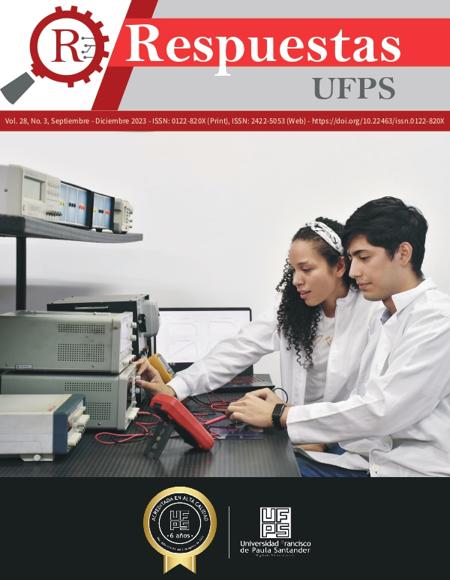Geometric Transformations vs Noise Induction: Comparison of data augmentation techniques for dermoscopic image analysis
Transformaciones geométricas vs Inducción de ruido: Comparación de técnicas de aumentado de datos para análisis de imágenes dermoscópicas
Main Article Content
The HAM10000 dataset, a collection of dermatoscopic images of skin lesions, has become a valuable resource for research in dermatology and machine learning. This study focuses on evaluating the efficiency of two data augmentation techniques applied to images from the HAM10000 skin cancer dataset. The techniques evaluated in this context were geometric transformations and Gaussian noise induction. In the methodological phase, the Principal Component Analysis (PCA) technique was implemented to compare the original images with those augmented by each approach. This analysis allowed a deeper understanding of the modifications introduced by each technique, offering insights on the preservation of relevant features for skin lesion classification. The results obtained revealed superior performance when employing the Gaussian noise induction technique. This technique proved to be particularly effective in improving the quality of the data set, contributing positively to skin cancer diagnostic tasks. The analysis through PCA not only supported the efficacy of the Gaussian noise induction technique, but also provided detailed insight into how this technique preserves crucial information during the data augmentation process. this study not only highlights the relevance of the HAM10000 dataset in dermatological research, but also emphasizes the importance of selecting appropriate data augmentation techniques, with Gaussian noise induction emerging as a highly efficient option for improving the accuracy of machine learning models applied to medical imaging in the context of skin cancer.
Downloads
Article Details
N. Razmjooy et al., “Computer-aided Diagnosis of Skin Cancer: A Review,” Current Medical Imaging Formerly Current Medical Imaging Reviews, vol. 16, no. 7, pp. 781–793, Jan. 2020, doi: 10.2174/1573405616666200129095242.
D. N. Dorrell and L. C. Strowd, “Skin Cancer Detection Technology,” Dermatol Clin, vol. 37, no. 4, pp. 527–536, 2019, doi: 10.1016/j.det.2019.05.010.
P. Tschandl, C. Rosendahl, and H. Kittler, “Data descriptor: The HAM10000 dataset, a large collection of multi-source dermatoscopic images of common pigmented skin lesions,” Sci Data, vol. 5, pp. 1–9, 2018, doi: 10.1038/sdata.2018.161.
A. S. Jahn et al., “Over-Detection of Melanoma-Suspect Lesions by a CE-Certified Smartphone App: Performance in Comparison to Dermatologists, 2D and 3D Convolutional Neural Networks in a Prospective Data Set of 1204 Pigmented Skin Lesions Involving Patients’ Perception,” Cancers (Basel), vol. 14, no. 15, Aug. 2022, doi: 10.3390/cancers14153829.
T. Saba, M. A. Khan, A. Rehman, and S. L. Marie-Sainte, “Region Extraction and Classification of Skin Cancer: A Heterogeneous framework of Deep CNN Features Fusion and Reduction,” Journal of Medical Systems 2019 43:9, vol. 43, no. 9, pp. 1–19, Jul. 2019, doi: 10.1007/S10916-019-1413-3.
H.-W. Huang, B. W.-Y. Hsu, C.-H. Lee, and V. S. Tseng, “Development of a light-weight deep learning model for cloud applications and remote diagnosis of skin cancers,” J Dermatol, vol. 48, no. 3, pp. 310–316, Mar. 2021, doi: 10.1111/1346-8138.15683.
A. Kumar and A. Vatsa, “Untangling Classification Methods for Melanoma Skin Cancer,” Front Big Data, vol. 5, no. March, pp. 1–11, 2022, doi: 10.3389/fdata.2022.848614.
N. Hameed, A. Shabut, and M. A. Hossain, “A Computer-Aided diagnosis system for classifying prominent skin lesions using machine learning,” in 2018 10th Computer Science and Electronic Engineering Conference, CEEC 2018 - Proceedings, IEEE, 2019, pp. 186–191. doi: 10.1109/CEEC.2018.8674183.
R. Baig, M. Bibi, A. Hamid, S. Kausar, and S. Khalid, “Deep Learning Approaches Towards Skin Lesion Segmentation and Classification from Dermoscopic Images - A Review,” Current Medical Imaging Formerly Current Medical Imaging Reviews, vol. 16, no. 5, pp. 513–533, Jan. 2019, doi: 10.2174/1573405615666190129120449.
A. Gupta and A. Barbu, “Parameterized principal component analysis,” Pattern Recognit, vol. 78, pp. 215–227, 2018, doi: 10.1016/j.patcog.2018.01.018.
A. K. Seghouane, N. Shokouhi, and I. Koch, “Sparse Principal Component Analysis with Preserved Sparsity Pattern,” IEEE Transactions on Image Processing, vol. 28, no. 7, pp. 3274–3285, Jul. 2019, doi: 10.1109/TIP.2019.2895464.
S. Wang and M. Hamian, “Skin Cancer Detection Based on Extreme Learning Machine and a Developed Version of Thermal Exchange Optimization,” Comput Intell Neurosci, vol. 2021, 2021, doi: 10.1155/2021/9528664.
W. Gouda, N. U. Sama, G. Al-Waakid, M. Humayun, and N. Z. Jhanjhi, “Detection of Skin Cancer Based on Skin Lesion Images Using Deep Learning,” Healthcare (Switzerland), vol. 10, no. 7, Jul. 2022, doi: 10.3390/healthcare10071183.
G. Campanella et al., “Deep Learning for Basal Cell Carcinoma Detection for Reflectance Confocal Microscopy,” Journal of Investigative Dermatology, vol. 142, no. 1, pp. 97–103, Jan. 2022, doi: 10.1016/J.JID.2021.06.015.
V. Nyemeesha and B. M. Ismail, “Implementation of noise and hair removals from dermoscopy images using hybrid Gaussian filter,” Network Modeling Analysis in Health Informatics and Bioinformatics, vol. 10, no. 1, Dec. 2021, doi: 10.1007/s13721-021-00318-2.
O. O. Abayomi-Alli, R. Damaševičius, S. Misra, R. Maskeliūnas, and A. Abayomi-Alli, “Malignant skin melanoma detection using image augmentation by oversampling in nonlinear lower-dimensional embedding manifold,” Turkish Journal of Electrical Engineering and Computer Sciences, vol. 29, no. 8, pp. 2600–2614, 2021, doi: 10.3906/elk-2101-133.
J. B. Li and H. Gao, “Sparse data-dependent kernel principal component analysis based on least squares support vector machine for feature extraction and recognition,” Neural Comput Appl, vol. 21, no. 8, pp. 1971–1980, 2012, doi: 10.1007/s00521-011-0600-z.
A. Lasisi and N. Attoh-Okine, “Principal components analysis and track quality index: A machine learning approach,” Transp Res Part C Emerg Technol, vol. 91, no. April 2018, pp. 230–248, 2018, doi: 10.1016/j.trc.2018.04.001.
Y. Zhu, C. Zhu, and X. Li, “Improved principal component analysis and linear regression classification for face recognition,” Signal Processing, vol. 145, pp. 175–182, 2018, doi: 10.1016/j.sigpro.2017.11.018.
N. Bakshi and V. Prabhu, “Face recognition system for access control using principal component analysis,” in ICCT 2017 - International Conference on Intelligent Communication and Computational Techniques, 2018, pp. 145–150. doi: 10.1109/INTELCCT.2017.8324035.
R. Cheripelli and K. R. Sri, “Evaluation of machine Learning Models for Credit Scoring,” Ingeniería Solidaria, vol. 16, no. 2798, pp. 2798–2805, 2020.







